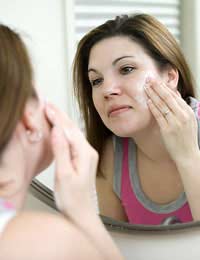Skin Inflammation and Hay Fever

Understanding why hay fever occurs is one part of a difficult battle for hay fever sufferers. Although we do know a great deal about the immune system and how it reacts to an allergen, there is still much mystery surrounding the reasons for this reaction. Aspects such as genetics have been identified as contributing factors but researchers still want to understand precisely what causes the immune system in some people to essentially overreact to an allergen. New research, however, has suggested that skin inflammation can set the stage for hay fever in the future.
Your Immune System
To understand how this newer research links to hay fever, it's important to first have a general sense of what occurs during a hay fever attack. For all of us, we rely on our immune systems to protect us from disease. Viruses, microbes and various other invaders are constantly around or on us; our immune system serves to identify invaders and then respond by eliminating them through various cells and systems that work cooperatively to keep us healthy. In allergy sufferers, however, the immune system responds inappropriately. Pollen, grass and many other normal and benign substances are viewed as foreign agents. The end result is that the immune system wages an attack on the harmless substance and produces various chemical mediators to protect the body. The main one of these is histamine, which leads to the characteristic redness, swelling, irritation, itching and congested nose that is often experienced during a hay fever reaction.
Chronic Inflammation
New research suggests that something as minor as a cut experienced by a child may prompt the beginnings of conditions such as hay fever. One reason for this is because hay fever involves chronic inflammation of various body tissues such as those lining the nose and throat. While current treatments have aimed to tackle the body's immune response to the allergen, researchers now believe that this is only one part off the battle. A study in the United States found that damage to the skin could result in the excessive production of a skin protein that is known as connexin 26. Yet, wouldn't everyone who suffers from a cut then end up with hay fever? This, however, isn't the case because the overproduction of the protein occurs in people who also have a defective form of the gene. In the average person, when the skin suffers from some sort of damage, this gene is turned on and it encourages the production of new skin cells. For normal individuals, the gene is turned off afterwards but for those with the defective gene, increased levels of the skin protein remain.
This excessive production of connexin 26 means that skin cells replicate at a very fast rate and thus, aren't able to divide and develop into fully functioning cells. The reduced quality of the cells prevents them from sending the correct chemical signals to turn off the gene and it also stops them from properly joining with neighbouring cells. Ultimately, the body's skin can't function as a proper barrier. Allergens are able to move through this poorly constructed barrier, where they react with the immune system and lead to an overly sensitive immune system.
Further research will hopefully yield ways to identify those with the defected gene and then develop ways to ensure the body responds appropriately to skin damage. The goal will be to prevent immune system hypersensitivity, which may eventually help to prevent hay fever from occurring.


Re: Common Symptoms Of Hay Fever
Few months ago I had anelegic reaction in under my eyes so I was prescribed steroids antihistamine they worked. Then few weeks…
Re: Rebound Nasal Congestion
I recently had a rhynectomy for sac since the operation I have been suffering from a severe blocked nose any body offer any advice
Re: Tree Pollen
Tender lymph glands in your neck under your chin are a sure sign of the body reacting to tree pollen. My glands have been tender since January but,…
Re: Tree Pollen
Does anyone know if Hawthorn causes hayfever please? We have a lot of Hawthorn at the bottom of our garden and I'm really suffering at the moment with…
Re: Tree Pollen
Having not really suffered from any Hayfever symptoms since 1988, I can honestly say that I have never felt so rough as I have these last 6-7 weeks. So…
Re: Tree Pollen
Do conifer trees cause big hayfever allergies? Massive conifer in our front garden which we have watched spewing out pollen for weeks, coating cars. I…
Re: Tree Pollen
I developed tree pollen allergy about fifteen years ago in my mid thirties. I had desensitisation injections for 3 years at Southmead hospital in my…
Re: Tree Pollen
I have been suffering from seasonal tree pollen hayfever for the past few years and in response to Katy, the timing of your discomfort is probably…
Re: Tree Pollen
First year I have experienced hay fever.started feeling rough in March sore throat and uvlia, had a large rash on upper torso.blocked nose in morning
Re: Tree Pollen
My hay fever is the worst it has ever been and I have been unable to go outside for over a week now or open a window. Just to get out of bed in the…